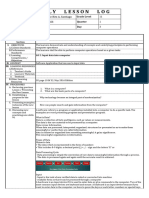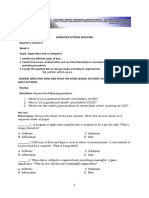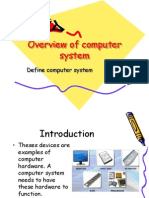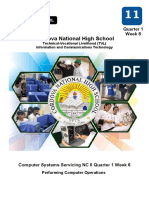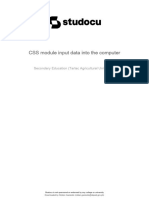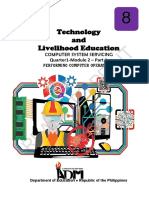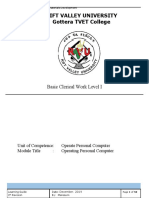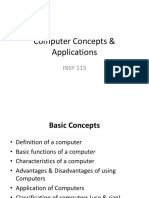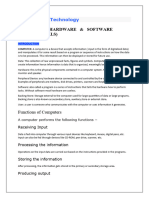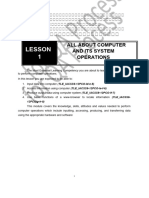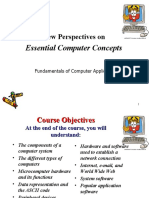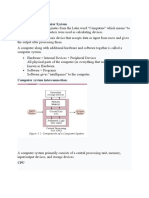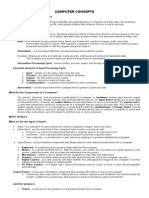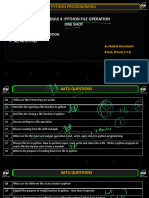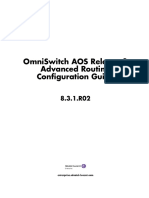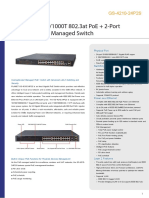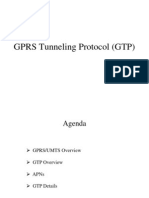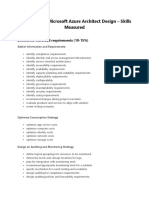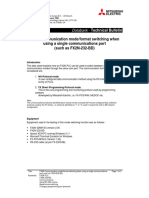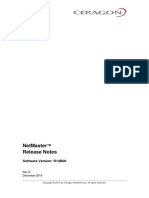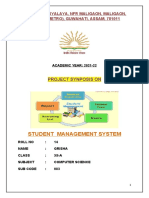Computer SENIOR HIGH
SCHOOL
Systems
Servicing NC II
Quarter 1 - Module 3
Performing Computer Operations
Department of Education
Division of Batangas City
Madeleine D. Mendoza || ICT Teacher || Paharang Integrated School
madeleine.mendoza@deped.gov.ph
1|Page
�How to Learn from this Module
To achieve the objectives cited above, you are to do the following:
• Take your time reading the lessons carefully.
• Follow the directions and/or instructions in the activities and exercises diligently.
• Answer all the given tests and exercises.
Icons of this Module
What I Need to This part contains learning objectives that
Know are set for you to learn as you go along the
module.
What I know This is an assessment as to your level of
knowledge to the subject matter at hand,
meant specifically to gauge prior related
knowledge
What’s In This part connects previous lesson with that
of the current one.
What’s New An introduction of the new lesson through
various activities, before it will be presented
to you
What is It These are discussions of the activities as a
way to deepen your discovery and under-
standing of the concept.
What’s More These are follow-up activities that are in-
tended for you to practice further in order to
master the competencies.
What I Have Activities designed to process what you
Learned have learned from the lesson
What I can do These are tasks that are designed to show-
case your skills and knowledge gained, and
applied into real-life concerns and situations.
2|Page
� 2 Input Data into Computer
What I Need to Know
At the end of this module, you should be able to:
1. Identify the types of programs/ applications software
2. Check the accuracy of information and save the information in accordance
with standard operating procedures
3. Classify the inputted data in storage media according to requirements
Technology has become the integral part of modernization in our society. It
opens door to information that will be needed by people who seeks knowledge through
the use of computer. Using computer, people can search and gain information by
simply accessing the internet. Just a click away, the information is being presented.
The things that are presented in the computer is simply coming from people
who puts information using computer. It is through the use of different programs/
applications software that could process the data being inputted by the person.
In this lesson, you will learn more about how a computer works.
3|Page
� What Is It
The importance of applying OHS in every task that we do in the workplace
or in a laboratory is to avoid any accidents and injuries in order to attain our
desired output in doing the task.
As a computer system servicing student, to attain the desired goal in the
task given, you must also familiarize the components of the computer and how
the computer works in order to avoid confusions.
Exercise:
What is the difference between a software and a hardware? Write your answers
below.
How Computer Works?
A computer is an electronic machine made up of hardware and software that work
together to do a task.
A software refers to a program or application installed into a computer to do a
specific task. The examples are word processing program and presentation program.
4|Page
�A hardware is computer parts or device that you can see or touch.
Each hardware performs a specific function. It could be as an Input Device or as an
Output Device.
What’s More
Exercise:
How can you relate the parts of the computer to a person?
What is Data?
Data is a collection of facts and figures, such as values or measurements.
The data is the raw material to be processed by a computer.
Data versus Information
When data are processed, interpreted, organized, structured or presented so as to
make them meaningful or useful, they are called information
5|Page
�6|Page
�Differences in Meaning
The raw input is data and it has no significance when it exists in that form. When
data is collated or organized into something meaningful, it gains significance.
This meaningful organization is information.
Types of Data
Numeric data
The data which is represented in the form of numbers
This includes 0-9 digits, a decimal point (.) +, /, - sign and the letters “E” or
“D”.
Character data
7|Page
�Data Processing Cycle
- Data processing is simply the conversion of raw data to meaningful
information through a process.
- The data is processed again and again until the accurate result is achieved.
Input
- Input is the task where verified data is coded or converted into machine
- readable form so that it can be processed through a computer
A hardware is an input device if it is used to enter data or give commands to the
computer. Two of the most common input devices are keyboard and mouse. A
keyboard is an input device because if you want to enter data to the computer, we
have to press the keys or each letter, numbers or special keys. A mouse is also an
input device because if you want to give instruction to the computer, we have to
press its buttons.
8|Page
�Processing
- Processing is when the data is subjected to various means and methods of
manipulation, the point where a computer program is being executed, and it
contains the program code and its current activity.
Classifying
Sorting
Calculating
Summarizing
Comparing
Output
- Output is presented to users in various report formats like printed report,
audio, video or on monitor.
Text
Graphics
Audio
Video
A hardware is an output device if it gives the results done by the computer. Some
of the common devices are: monitor, which displays the text, graphics and
documents done in the computer; the printer, it prints on the paper the text and
graphics that you have inputted to. Speakers and headphones are output device
because through them you could hear sounds and music coming from your
computer.
Storage
- Storage is a location which data instruction and in which data, instruction and
information are held for future use
- Every computer uses to hold system software and application software
- A storage medium, also called secondary storage is the physical material in
the computer that keeps data, instruction and information.
Types of Data Processing
Manual Data Processing
The process of data entry implies many opportunities for errors, such as:
Delays in data capture
A high amount of operator misprints,
High labor costs from the amount of manual labor required etc.
9|Page
�Electronic data processing
Use of computers for recording, manipulating, and summarizing data
Computer can help
Accuracy
Speed
Consistency
Storage capacity
Automation
Computer data processing
The eleven data of processing operations in a computer are:
Recording
Verifying
Duplicating
Classifying
Sorting
Calculating
Summarizing and reporting
Merging
Storing
Retrieving
Feedback
The components involved data processing
Central Processing Unit (CPU)
Computer Memory (RAM and ROM)
Data bus
Ports
Motherboard
Hard disk
Output Devices
Input Devices
10 |
Page
�Central Processing Unit (CPU)
Computer Memory (RAM and ROM)
When the computer is doing any job, the data that have to be
processed are stored in the primary memory
The following terms related to memory of a computer are discussed
below:
o Random Access Memory (RAM)
o Read Only Memory (ROM)
o Programmable read-only memory (PROM)
o Cache Memory
o Registers
11 |
Page
�Input Devices
- Keyboard: The layout of keyboard is just like the traditional typewriter of the
type QWERTY
- Mouse: It rolls on a small ball and has two or three buttons on the top
- Scanner: Scanner is an optical device that can input any graphical matter and
display it back
Output Devices
- Visual Display Unit: It is also called the monitor
- Speaker
- Printer: It is an important output device which can be used to get a printed
copy of the processed text or result on paper.
12 |
Page
�Computer Processing Operations
A computer can perform only the following four operations which enable computers
to carry out the various data processing activities we have just discussed
- Input/Output Operations
- Calculation and text manipulation operations
- Logic/Comparison Operations
- Storage and Retrieval Operations
13 |
Page
� What’s More
Give atleast 5 examples of input devices
1. __________________
2. __________________
3. _________________
4. __________________
5. _________________
Give atleast 3 examples of output devices
1. ____________
2. ___________
3. _____________
Why is data important?
What I Have Learned
Make a concept map about data processing.
14 |
Page
� What I Can Do
Differentiate manual data processing and electronic data processing and cite some
examples.
15 |
Page
�K -12 Department of Education- PC Hardware Servicing Learning Module
http://www.depedbataan.com/resources/9/k_to_12_pc_hardware_servicing_learning_modul
e.pdf
CBC CHS NC11 Common Perform Computer Operations
https://docs.google.com/a/deped.gov.ph/viewer?a=v&pid=sites&srcid=ZGVmYXVsdGRvbW
FpbnxmaXh1cnBjMTk3NHxneDo3MzJmZGI1MTJlOGU0Mzlm
Lam To, Computer Data Processing
https://www.slideshare.net/lamto01111995/computer-data-processing
K-12 Department of Education - TLE ICT learning module
file:///C:/Users/Teacher/Downloads/TLE_ICT_CHS_GRADE_10_LM.pdf
Namibia University of Science and Technology
https://www.nust.na/sites/default/files/documents/Occupational%20Health%20and%20Safet
y%20Test%201%20-%20Memorandum.pdf
https://obabv.com/images/proefexamen/ENGELS_B_VCA_2014.pdf
https://www.biiab.org/fileadmin/content/Documents/Specimen_questions/HS_Specimen_Qs
_January_2012.pdf
https://pdfslide.net/documents/uc-6-perform-computer-operationsdoc.html
https://en.wikipedia.org/wiki/Information_access
16 |
Page
� 17 |
Page

